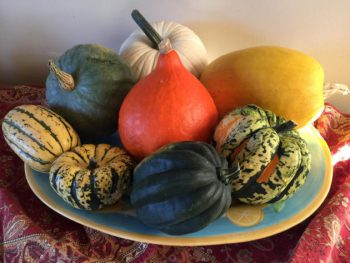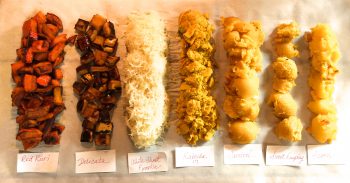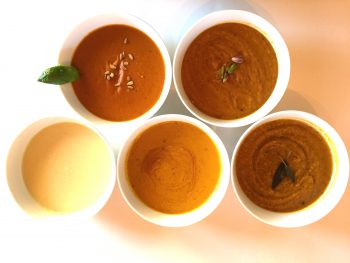
BY DENISE MILLER / FOR THE JOURNAL
Wednesday, October 9th, 2019
If there are any vegetables that announce October, winter squash and pumpkins are at the top of the list.
Acorn, butternut and spaghetti squash are great fall staples, and at growers’ markets, you can also find less common varieties, such as red kuri, carnival and sweet dumpling. Pumpkins, still technically squash, include sweet pie pumpkins and white ghost that are good to eat, and large ornamentals that are best left for Halloween carving.

From left to right: delicata, kombucha, white ghost pumpkin, spaghetti, carnival, acorn, sweet dumpling, red kuri.
If you like pumpkins, Jack-o-lanterns or world records, you might want to visit Los Alamos to watch or participate in the planned smashing of the Guinness World Record for “Most People Carving Pumpkins Simultaneously.” (Get more details here.)

Steve Ness, Ness Farms with pumpkins for the contest.
Starting at 3 p.m. on Oct. 26 in downtown Los Alamos, 1,300 people will start carving pumpkins in pursuit of breaking the current world record, which stands at 1,060 pumpkins, now held by Rio Rancho.
But the best part of this story may not even make it into the record books: all 1,300 pumpkins that will be carved in Los Alamos are grown locally by Steve Ness of Ness Farms in Estancia. In order to qualify for the competition, each pumpkin must weigh a minimum of 25 pounds. This translates into 65 bins of pumpkins weighing a total of more than 32,500 pounds.
Now that you’re thinking orange, let’s get to the more edible varieties of squash. (* indicates varieties in this month’s Test Kitchen.)
Acorn is named for its acorn-like shape and relatively small size. It is usually dark green on the outside, with a very mild flavored flesh.*
Buttercup looks similar to kabocha, but has a bottom side with a distinct circular area and bump that is often referred to as a “turban.” Buttercups have a mild taste.
Butternut is tannish in color and has a large bell-shaped bottom section and a slimmer, tapering neck. The orange/yellow flesh of butternut is known for its sweet and nutty flavor.
Blue Hubbard is a grayish-blue-skinned variety with a bumpy texture that comes in a variety of sizes from fairly small to extremely large.
Carnival: This small variety has vibrant patterns of orange and green stripes. The skin is tender, and its flavor is nutty and mildly sweet.*
Delicata has a thin and tender pale yellow skin with green stripes. Its skin is edible and its meat is sweet! Many recipes feature delicata squash and sweet potatoes.*

Cooked squash with labels.
Dumpling: Small, round, a little yellow, with green stripes on the outside, this squash has sweet, tender orange flesh.*
Kabocha and Red Kabocha are either green with light yellow stripes or reddish-orange with barely visible white stripes. Sometimes they have a slighty flattened top. Kabocha are savory, and they are drier and denser than most squash.*
Red Kuri are a deep orange and have a fig or tear-drop shape. They are a smaller hubbard squash with edible skin, and a savory flavor that some describe as chestnut-like.*
Spaghetti has a distinct oblong shape and, once cooked, the flesh tends to separate into long thread-like pieces when scraped with a knife, fork, or spoon. Spaghetti squash is great used in place of pasta.
White Ghost Pumpkins have distinctive white skin and are best suited for baking, roasting and boiling. The flesh is stringy (like grated carrot), but when pureed, it is has a mild, slightly starchy taste, not unlike a potato.*
Many older farmers I know refer to all squash as pumpkins, but usually your local farmer can tell you all about the varieties they grow. Choose squash that are firm and heavy for their size. Check that the stem is attached, as this can be a source of rot.
Rinse the squash under cold running water before cutting. Cutting a winter squash is usually the hardest part of preparing one, so if you are struggling, leave it whole, pierce it a few times with a fork or the tip of a paring knife, then bake it, and scoop out the seeds after it has been cooked.
Baking and roasting are two common, but different, methods of cooking. Baking is done at a lower heat for a longer period of time, typically between 325°F-375°F. This method evenly cooks food throughout. Baking a butternut squash is the best way to evenly cook two whole halves. Roasting is done at a higher temperature, usually between 400°F-450°F, for a shorter period of time. This method brings out the sugars and helps the vegetable caramelize.
My kitchen test included cooking seven squash varieties. The sweetest – by far – were the sweet dumpling and delicata. The acorn and carnival were also sweet, and very similar to each other, which makes sense since carnival is a hybrid of acorn and dumpling. The kabucha was dry. This a good one to use in soups or to mix with other squash.
There are countless ways to enjoy winter squash. Here are just a few ideas:
• Top puréed winter squash with cinnamon and maple syrup
• Toss cold roasted butternut squash cubes with your favorite spinach salad
• Cube and roasted as a meatless filling in tacos or add it to your favorite chili for texture and color,
• Add puréed squash to a lasagna
• Make a fall quinoa salad with cooked quinoa, roasted squash, shredded Brussels sprouts, a simple oil and vinegar dressing, and top it with dried cranberries and some pumpkin seeds
Many – but not all – local growers’ markets will close for the season by the end of October, so get outside, support your local farmers and stock up on some versatile, healthy squash.
Test Kitchen Notes

Soups (from top left to bottom): Mexican with lime, pistachio, white ghost, curry, Mediterranean
For these soup recipes, the general technique and most ingredients remain the same. Spices and a few ingredients change.
Only the white pumpkin was baked. It was baked at 350°F for an hour, cut side down on a sheet pan with some water around it. Other squash were roasted at 425°F for about 40 minutes. Each squash was coated in olive oil, salt and pepper. Only the delicata and red kuri were roasted (and cubed) with their skins on. The rest were halved and roasted cut side up. Baking sheets were lined with foil to make clean up easier, but parchment paper works, too.
With the exception of the Thai-inspired White Pumpkin Soup, each soup used a combination of all the roasted squash mixed together. Use any squash you have or a combination. For uniform color, remove skin. If you are using a thin-skinned squash, you can skip the step of pre-cooking and just let it soften (until fork tender) in the broth.
All recipes serve 4-6 people.
MEDITERRANEAN: SAGE-GARLIC SQUASH SOUP
Sage is the key ingredient that gives this a decidedly French or Mediterranean flavor.
- 4 cups of cooked winter squash (about 1½ pounds uncooked)
- 4 cups chicken or vegetable stock
- 1 chopped medium onion
- 2 tablespoons olive oil
- 1 tablespoon garlic, minced
- 1 tablespoon fresh sage, minced
Heat oil in soup pot. Add onion and cook for 5 minutes. Add minced garlic and sage, cooked squash and stock. Simmer for about 15 minutes and blend. Garnish with sage leaves browned in butter, if you like.
SOUTH ASIA: THAI-INSPIRED WHITE PUMPKIN SOUP
White pumpkin is mellow and potato-like in this soup, and coconut milk and fresh ginger give it a hint of Thai.
- 4 cups of White Ghost Pumpkin (about 1½ pounds uncooked)
- 2 cups chicken or vegetable stock
- 2 cups coconut milk
- 1 chopped medium onion
- 2 tablespoons grapeseed or other neutral oil (like corn, safflower or sunflower)
- 1 tablespoon garlic, minced
- 2 tablespoons (or more) fresh ginger, grated
Heat oil in soup pot. Add onion and cook for 5 minutes. Add minced garlic, ginger, cooked squash and stock. Simmer for about 15 minutes. Add coconut milk and blend. Add white pepper and cayenne, to taste.
SOUTH ASIA: CURRIED SQUASH SOUP WITH APRICOTS
- 4 cups of cooked winter squash (about 1½ pounds uncooked)
- 4 cups chicken or vegetable stock
- 1 chopped medium onion
- 2 tablespoons grapeseed or other neutral oil
- 1 tablespoon (or more) fresh ginger, minced
- 1 tablespoon curry powder
- 1 cup chopped dried apricots
- Toasted pistachios or other nuts for garnish, if desired
Heat oil in soup pot. Add onion and cook for 5 minutes. Add minced garlic, ginger, curry powder, cooked squash, apricots and stock. Simmer for about 15 minutes and blend. Garnish with toasted pistachios or other nuts, if you like.
EAST ASIA: MISO SQUASH SOUP WITH COCONUT MILK
Sweet and savory, the sesame oil drizzle completes this heavenly soup.
- 4 cups of cooked winter squash (about 1½ pounds uncooked)
- 4 cups water (instead of stock)
- 1/3 cup miso
- 1 chopped medium onion
- 2 tablespoons grapeseed or other neutral oil
- 2 tablespoons (or more) fresh ginger, minced
- Sesame oil, drizzle for finish, if desired
Heat oil in soup pot. Add onion and cook for 5 minutes. Add minced garlic, ginger and water. When the liquid is hot, whisk in the miso. Simmer for about 15 minutes and blend. Garnish: drizzle with sesame oil, if you like.
LATIN AMERICA: CHIPOTLE SQUASH SOUP WITH LIME
You’ll recognize this Mexican-inspired flavor and discover how well chile and lime complement squash.
- 4 cups of cooked winter squash (about 1-1½ lbs. uncooked)
- 4 cups chicken or vegetable stock
- 1 chopped medium onion
- 2 tablespoons grapeseed or other neutral oil
- 1 or 2 canned chipotle chiles with some of their adobo sauce (or several tablespoons of adobo sauce)
- 1 lime, juiced
- Garnish: toasted pepitas (pumpkin seeds)
- Heat oil in soup pot. Add onion and cook for 5 minutes. Add minced garlic, chiles and adobo, squash and stock. Simmer for about 15 minutes and blend. Add lime juice. Garnish with toasted pepitas, if desired.
Denise Miller is executive director of the New Mexico Farmers’ Marketing Association. Visit farmersmarketsnm.org.

